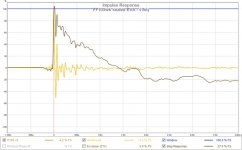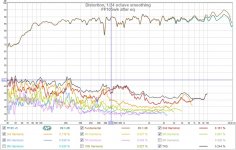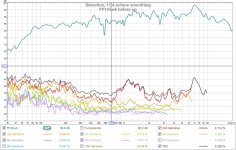This build was inspired from a design by Jeshi and first posted in the EVA foam speaker thread here. I decided that I like this speaker enough to warrant its own thread.
Here is Jeshi's little FF105WK EVA foam monitor:
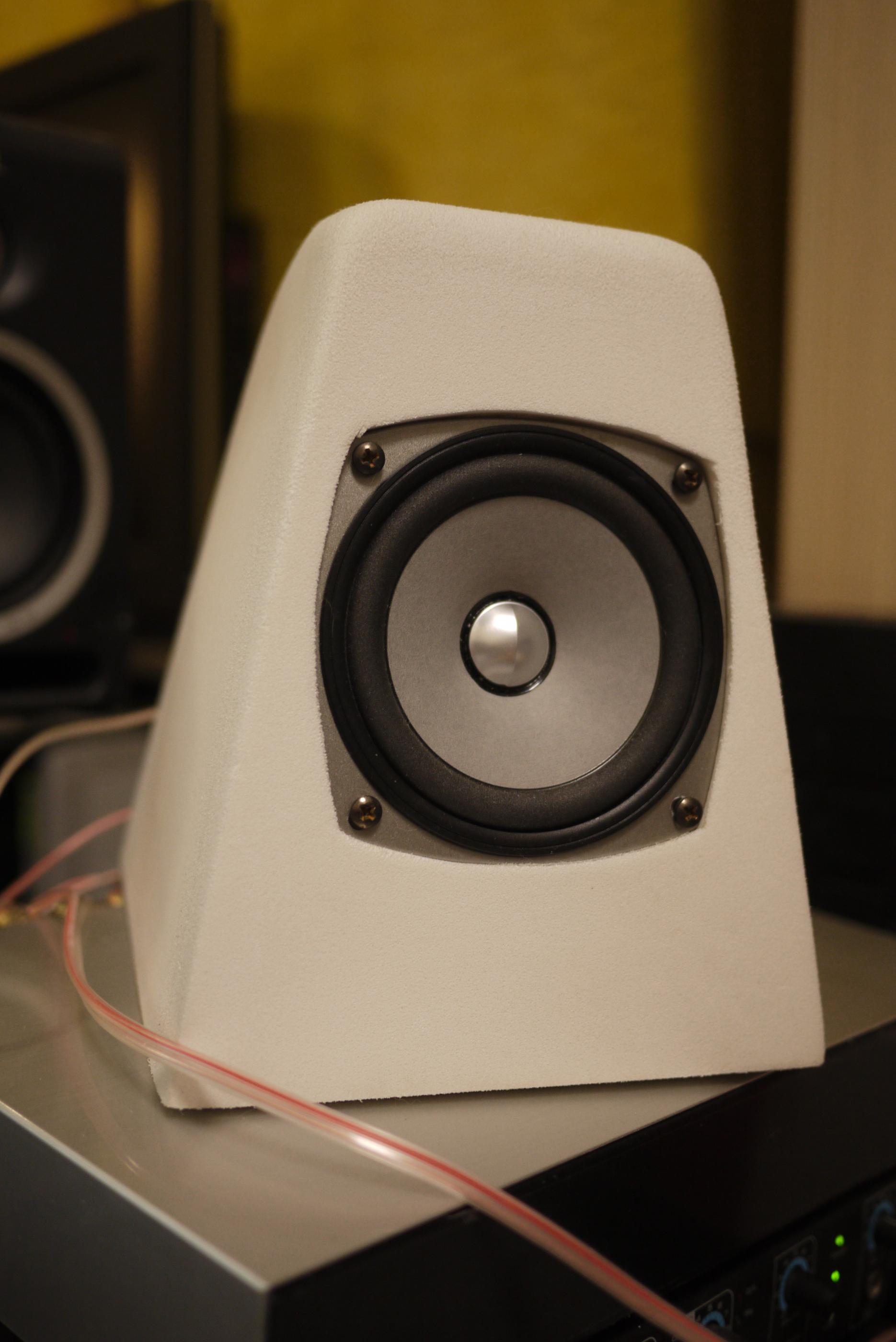
Here is a recap of what was posted previously, with some additional info on the modeling and new measurements at the listening position.
I liked the shape of Jeshi's EVA foam monitors so much, I decided to follow something similar with rounded edges and a trapezoidal baffle - this shape minimizes baffle diffraction effects. I have a set of FF105WK's that I wanted to use for this as Jeshi said she really likes how they work once some EQ is applied. However, i went for a different twist and rather than sealed, I made a tapered vent TL. The TL has a 3:2:1 proportion on the three internal passages which starts at 4in to 2.70in to 1.35in with 13in long for each segment and a 5.0in internal width. The sim on Akabak predicted a tuning frequency of 60Hz and flat response in the absence of baffle step losses.
Here is the simulation of the TL response with no baffle step losses:
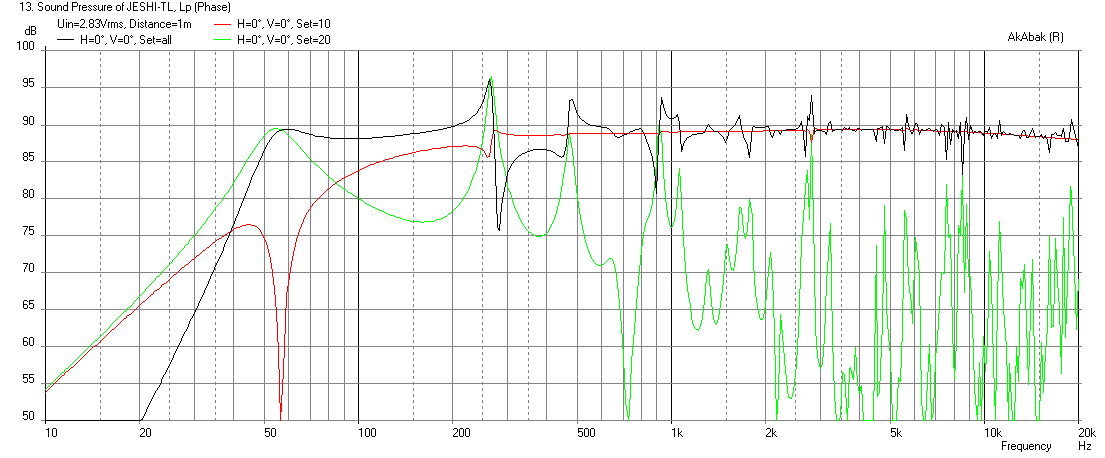
Here is the sim accounting for baffle step losses (pretty drastic isn't it?):
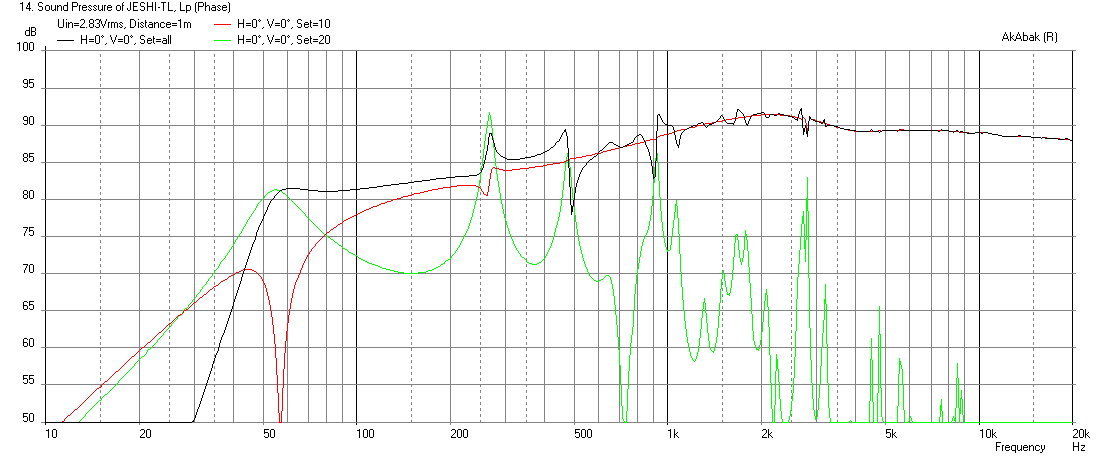
Now if we add a 1mH+5R BSC to help even the response we get this predicted response:
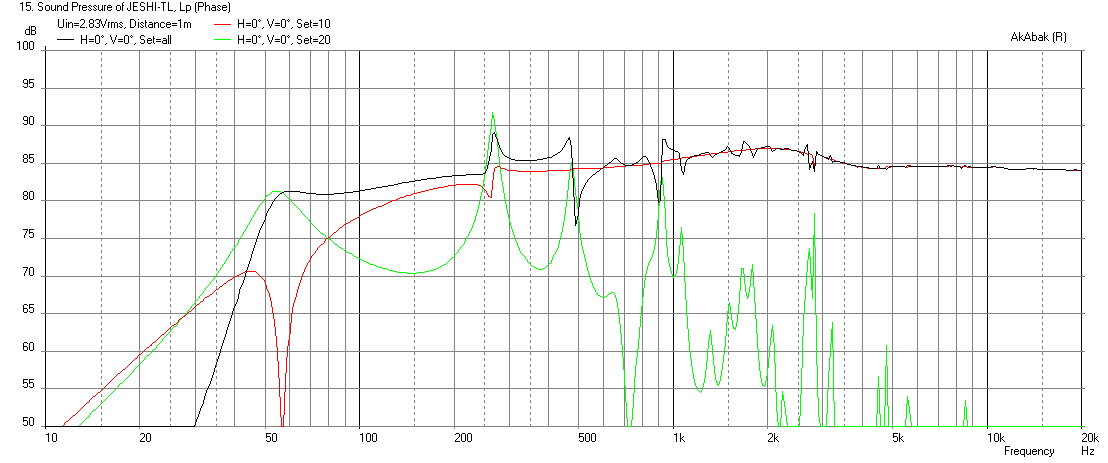
Here is a photo of the internals before the side was capped:
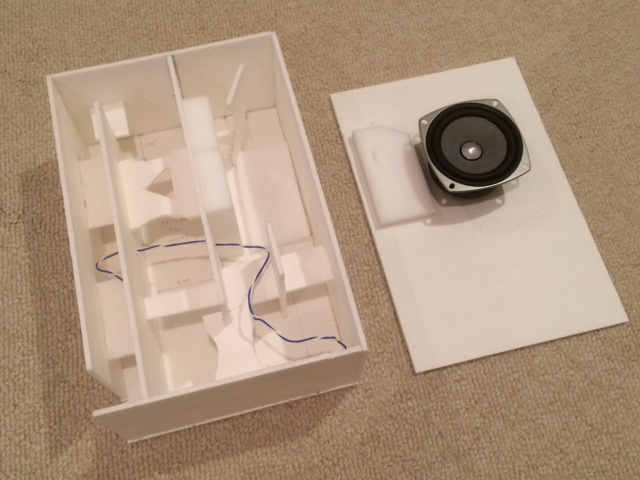
Here is the finished speaker with a compound curved baffle that has a large radius of curvature at the top and smaller at the bottom. The front baffle is comprised of 3 layers of foam core with 2 layers of Liquid Nails (low VOC) for CLD, and the top has two layers with one layer of CLD - they sound very dull under the "rap the knuckles" test:
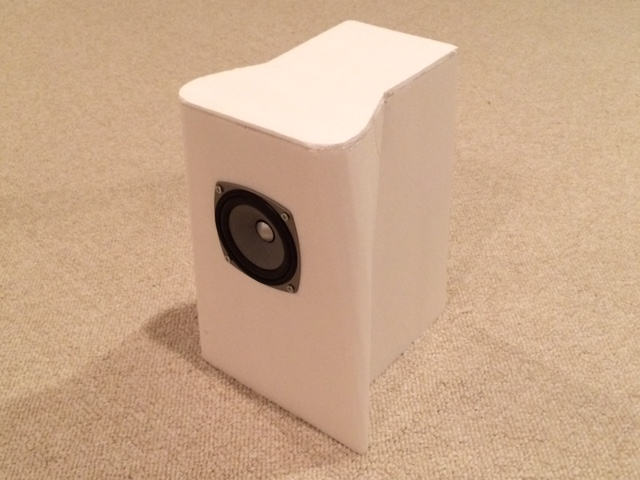
Internally, I lined the areas directly behind the driver and adjacent with phenolic BASF sound abatement foam (available as Mr Clean magic eraser sponges), adn stuffed the closed end with fiberglass and a small wad of fiberglass at the first bend on the bottom.
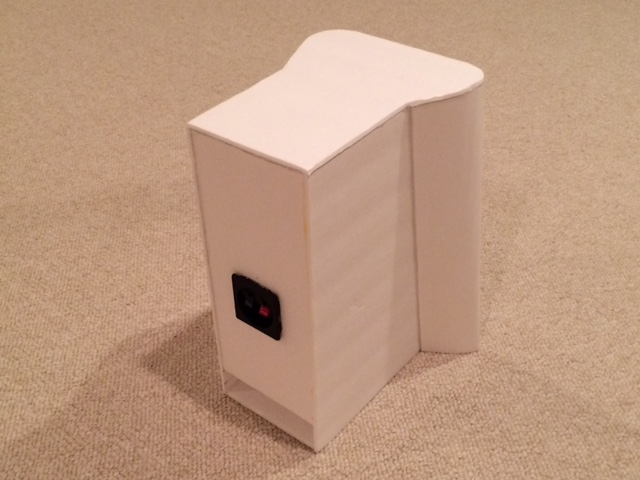
Here is a nice detail showing the compound variable radius of curvature side edges (large radius at top to smaller radius at bottom). Using traditional score and bend techniques discussed in the Cornu thread.
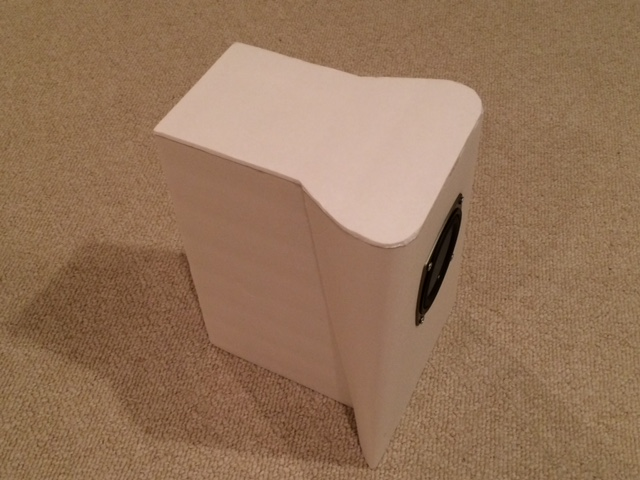
Here is the front view (9.5in wide at base in front, 7.5in wide at top in front x 5.25in wide at back x 9.5in deep x 13.75in high):
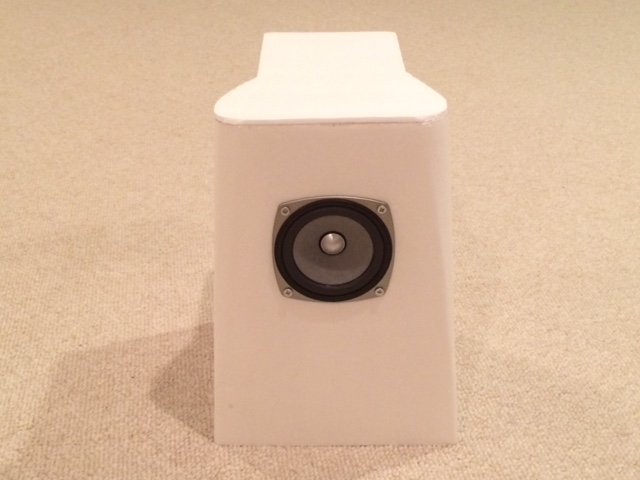
Here are the measurements before the curved baffle and with a few levels of BSC (5 ohms and 8.2ohms with a 1mH coil). I have not connected it to miniDSP yet and wanted to see how flat I could get it passively. This is with 5ms gate and mic was 0.5m away with speaker on 30in tall stand (red is before curved baffle, dark blue is with curved baffle and BSC - 1mH + 5R):
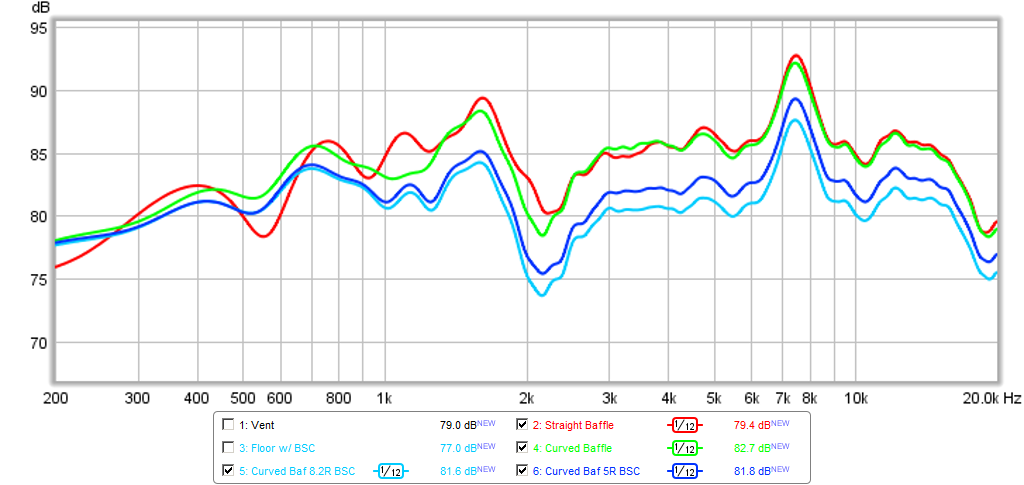
The dip at 2.1kHz and peak at 7.5kHz are inherent to the FF105WK (see manufacturer's response graph).
Here is the TL vent output (mic 2in from vent :
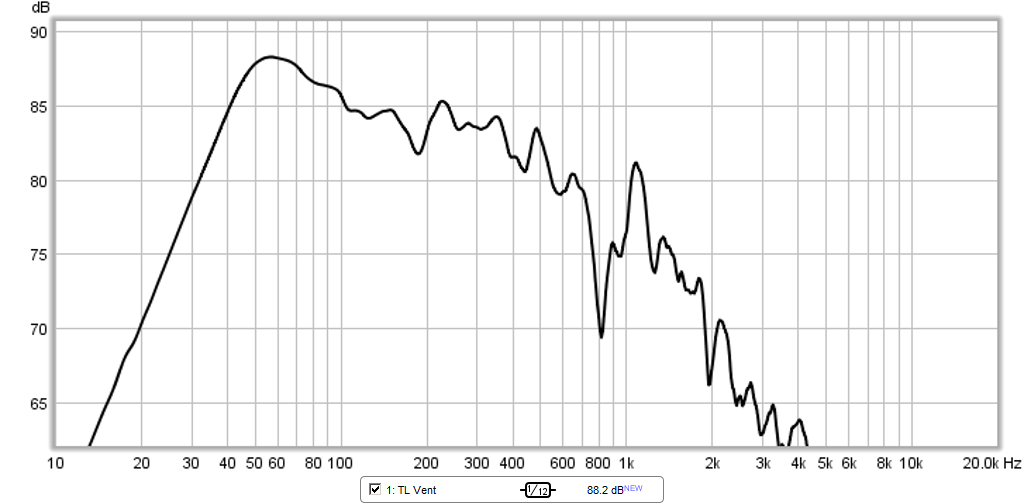
Here is the phase:
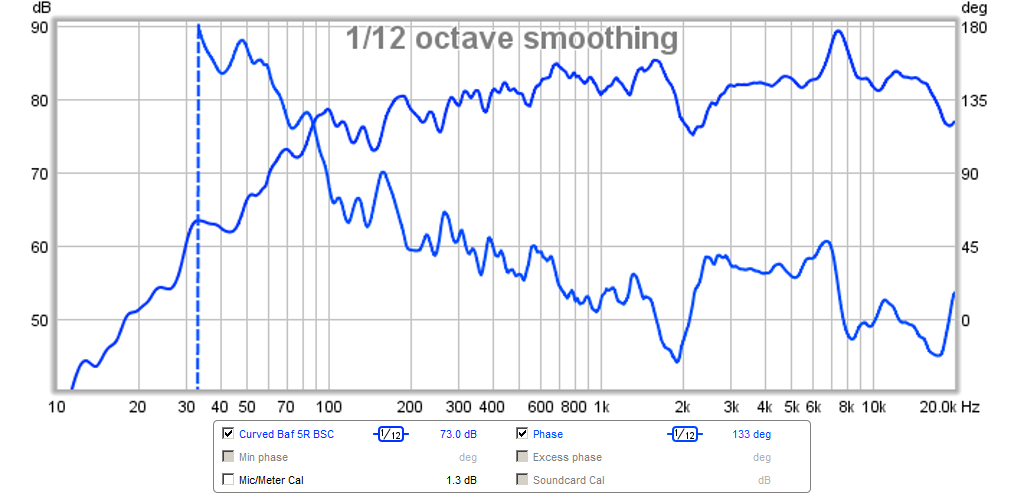
Here is the Impulse Response:
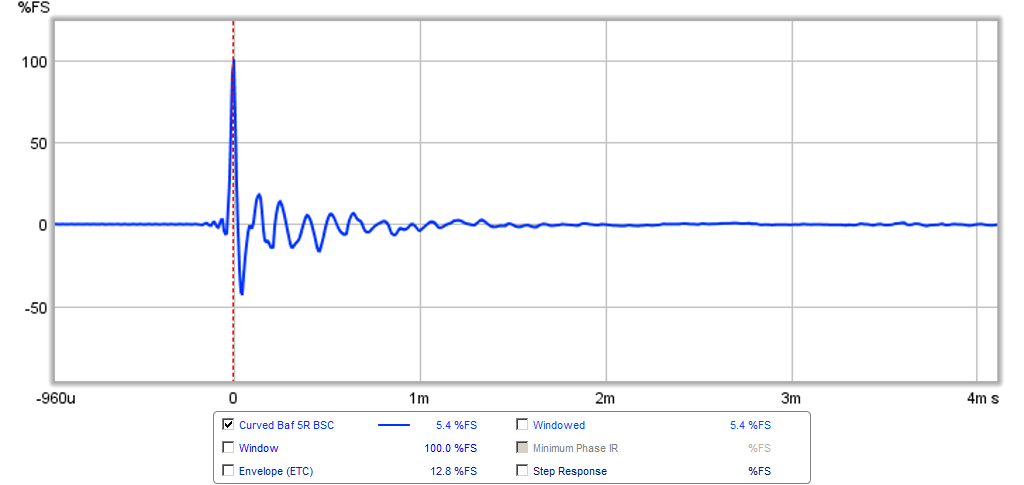
The vent output is pretty impressive as a lot of air is moved over a vent area that is about 84% of the area of the cone. When used on a desk near a back wall, there is a lot more bass gain and you can hear it down to about 60hz. When used in 4pi space the rear firing vent falls off quickly and bass extend to about 100Hz. Here is the measured impedance sweep showing the tuning frequency is 60Hz, matching the predicted value in the simulation on Akabak.
Here is measured impedance, showing fb matches predicted 60Hz tuning frequency:
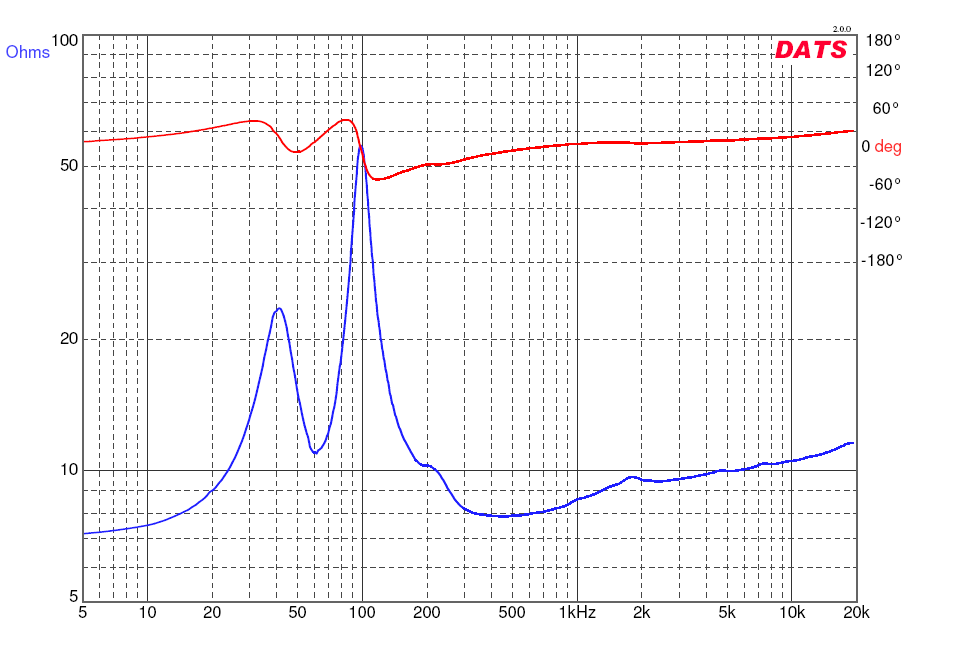
So where is the bass? Well it is rear firing, and when the speaker is placed on a stand in the middle of the room it is like 4pi space so there is not much bass. However, place it on a shelf 12in away from a back wall and use it near field on a desk and the response changes quite a bit - the bass is very apparent and extends to about 55Hz. Here are the measurements at the listening position (LP) - there are a lot of reflections and bounce nulls from desk and objects nearby but nonetheless it sounds quite nice as you will hear from a sound clip to follow. The is is the measured frequency response at the LP:
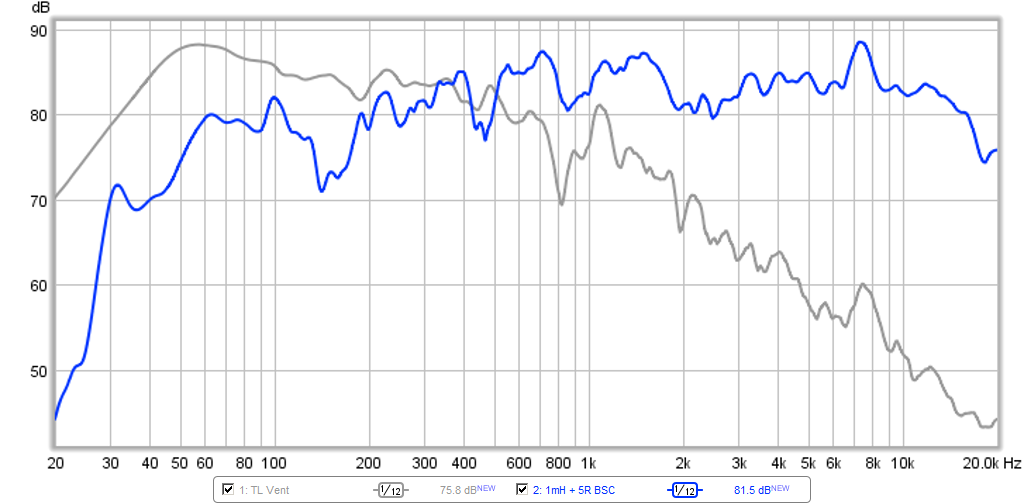
This is the measured harmonic distortion at the LP:
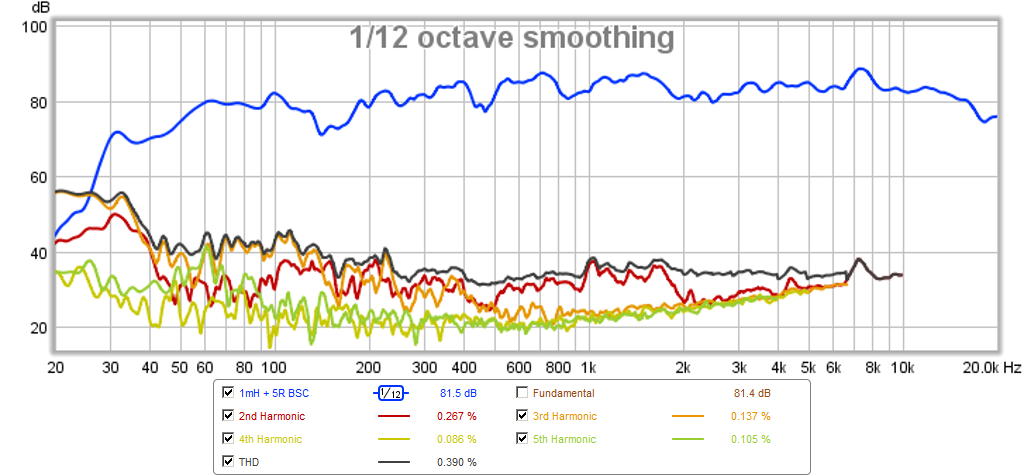
This is the measured Impulse and Step Response (transient perfect) at the LP:
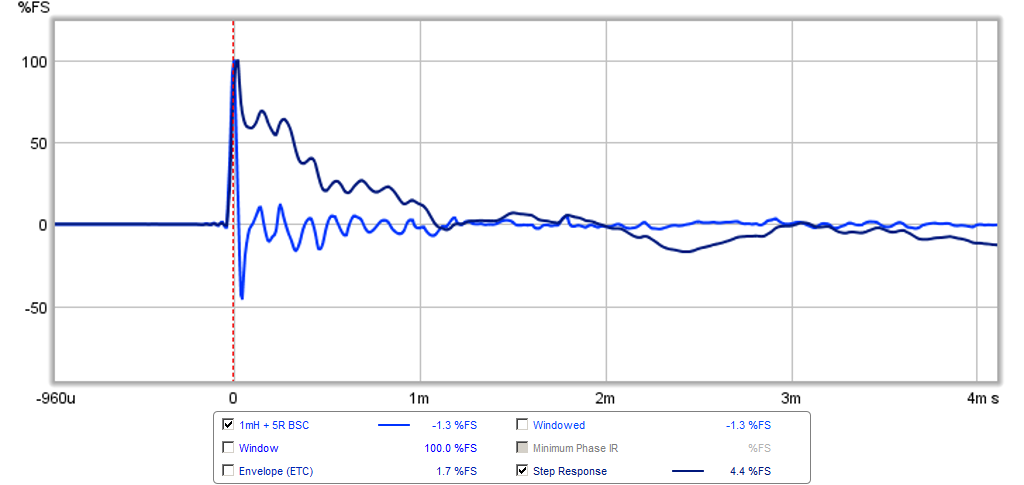
This is all done without any EQ or DSP - just a passive BSC and plain amp driving full range. Starting here there should be minimal work to flatten it out with the DSP EQ in a program like Jriver.
PDF plan (pencil hand sketch scanned - so a bit blurry but readable.
Here is a sound clip: http://www.diyaudio.com/forums/attachments/full-range/502910d1441692190-eva-foam-performance-speaker-enclosures-ff105wk-tl-clip1.asc
Here is Jeshi's little FF105WK EVA foam monitor:

Here is a recap of what was posted previously, with some additional info on the modeling and new measurements at the listening position.
I liked the shape of Jeshi's EVA foam monitors so much, I decided to follow something similar with rounded edges and a trapezoidal baffle - this shape minimizes baffle diffraction effects. I have a set of FF105WK's that I wanted to use for this as Jeshi said she really likes how they work once some EQ is applied. However, i went for a different twist and rather than sealed, I made a tapered vent TL. The TL has a 3:2:1 proportion on the three internal passages which starts at 4in to 2.70in to 1.35in with 13in long for each segment and a 5.0in internal width. The sim on Akabak predicted a tuning frequency of 60Hz and flat response in the absence of baffle step losses.
Here is the simulation of the TL response with no baffle step losses:

Here is the sim accounting for baffle step losses (pretty drastic isn't it?):

Now if we add a 1mH+5R BSC to help even the response we get this predicted response:

Here is a photo of the internals before the side was capped:

Here is the finished speaker with a compound curved baffle that has a large radius of curvature at the top and smaller at the bottom. The front baffle is comprised of 3 layers of foam core with 2 layers of Liquid Nails (low VOC) for CLD, and the top has two layers with one layer of CLD - they sound very dull under the "rap the knuckles" test:

Internally, I lined the areas directly behind the driver and adjacent with phenolic BASF sound abatement foam (available as Mr Clean magic eraser sponges), adn stuffed the closed end with fiberglass and a small wad of fiberglass at the first bend on the bottom.

Here is a nice detail showing the compound variable radius of curvature side edges (large radius at top to smaller radius at bottom). Using traditional score and bend techniques discussed in the Cornu thread.

Here is the front view (9.5in wide at base in front, 7.5in wide at top in front x 5.25in wide at back x 9.5in deep x 13.75in high):

Here are the measurements before the curved baffle and with a few levels of BSC (5 ohms and 8.2ohms with a 1mH coil). I have not connected it to miniDSP yet and wanted to see how flat I could get it passively. This is with 5ms gate and mic was 0.5m away with speaker on 30in tall stand (red is before curved baffle, dark blue is with curved baffle and BSC - 1mH + 5R):

The dip at 2.1kHz and peak at 7.5kHz are inherent to the FF105WK (see manufacturer's response graph).
Here is the TL vent output (mic 2in from vent :

Here is the phase:

Here is the Impulse Response:

The vent output is pretty impressive as a lot of air is moved over a vent area that is about 84% of the area of the cone. When used on a desk near a back wall, there is a lot more bass gain and you can hear it down to about 60hz. When used in 4pi space the rear firing vent falls off quickly and bass extend to about 100Hz. Here is the measured impedance sweep showing the tuning frequency is 60Hz, matching the predicted value in the simulation on Akabak.
Here is measured impedance, showing fb matches predicted 60Hz tuning frequency:

So where is the bass? Well it is rear firing, and when the speaker is placed on a stand in the middle of the room it is like 4pi space so there is not much bass. However, place it on a shelf 12in away from a back wall and use it near field on a desk and the response changes quite a bit - the bass is very apparent and extends to about 55Hz. Here are the measurements at the listening position (LP) - there are a lot of reflections and bounce nulls from desk and objects nearby but nonetheless it sounds quite nice as you will hear from a sound clip to follow. The is is the measured frequency response at the LP:

This is the measured harmonic distortion at the LP:

This is the measured Impulse and Step Response (transient perfect) at the LP:

This is all done without any EQ or DSP - just a passive BSC and plain amp driving full range. Starting here there should be minimal work to flatten it out with the DSP EQ in a program like Jriver.
PDF plan (pencil hand sketch scanned - so a bit blurry but readable.
Here is a sound clip: http://www.diyaudio.com/forums/attachments/full-range/502910d1441692190-eva-foam-performance-speaker-enclosures-ff105wk-tl-clip1.asc
Attachments
-
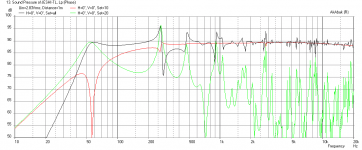 JESHI-FF105WK-TL-Freq-1m.png51.9 KB · Views: 3,063
JESHI-FF105WK-TL-Freq-1m.png51.9 KB · Views: 3,063 -
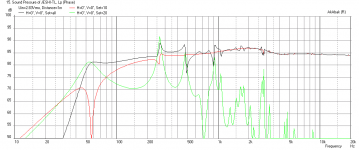 JESHI-FF105WK-TL-Freq-1m-with-baffle-step-5R-BSC.png16.3 KB · Views: 2,966
JESHI-FF105WK-TL-Freq-1m-with-baffle-step-5R-BSC.png16.3 KB · Views: 2,966 -
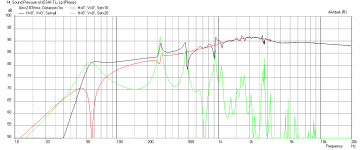 JESHI-FF105WK-TL-Freq-1m-with-baffle-step.png16.6 KB · Views: 3,038
JESHI-FF105WK-TL-Freq-1m-with-baffle-step.png16.6 KB · Views: 3,038 -
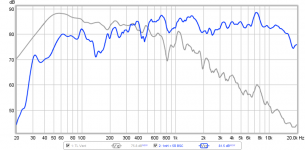 ff105wk-tl-bsc-at-lp.png82.2 KB · Views: 2,997
ff105wk-tl-bsc-at-lp.png82.2 KB · Views: 2,997 -
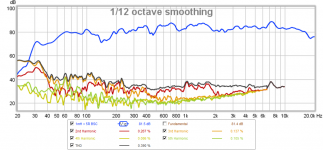 ff105wk-tl-bsc-at-lp-hd.png140.8 KB · Views: 2,684
ff105wk-tl-bsc-at-lp-hd.png140.8 KB · Views: 2,684 -
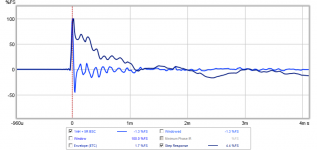 ff105wk-tl-bsc-at-lp-ir-sr.png54.5 KB · Views: 2,660
ff105wk-tl-bsc-at-lp-ir-sr.png54.5 KB · Views: 2,660 -
FF105WK TL -plan.pdf79.8 KB · Views: 283
Last edited:
Video of TL vent action
The TL vent moves a lot of air, and does so with super snappy acceleration. Here is a video of the vent with a song playing at moderate volume around 83dB. This is what I mean by "snappy" bass.
Change extension to .mov to watch in Quicktime.
The TL vent moves a lot of air, and does so with super snappy acceleration. Here is a video of the vent with a song playing at moderate volume around 83dB. This is what I mean by "snappy" bass.
Change extension to .mov to watch in Quicktime.
Attachments
Sound clip with bass
Here is a sound clip recorded at listening position to show the fullness of the bass that can be achieved with this little TL. Change extension to .mp3 to listen.
Also clip of vocals from RP.
Here is a sound clip recorded at listening position to show the fullness of the bass that can be achieved with this little TL. Change extension to .mp3 to listen.
Also clip of vocals from RP.
Attachments
Last edited:
This is a great design for the FF105wk! I do really like the FF105wk in my sealed truncated pyramid rhomboid box after EQing out the problem areas and making a baffle step adjustment.
I definitely want to build one of these (or a variation on it).
I definitely want to build one of these (or a variation on it).
I think you said you wanted a front firing TL vent. I think it can be reformatted by making the first three paths 3in shorter and then making the last turn turn 90deg and to the front for the last 9in towards the front. It will be a little more stout looking. I think I should work well though. With that many turns the Hf's should be low pass filtered out pretty well. Are you going to make it with EVA? I feel a lot of dynamic thumping pressure along the line maybe the EVA will actually help to smooth out the resonances.
Yeah I want to make a front firing version similar to the PMC TwoTwo.5 but using just the FF105wk like you do.

And I am thinking to do a carved, faceted front baffle to get close to my rhomboid pyramid shape. Something similar to Troel's EllamFlex or Illumina66

My plan is to use EVA foam and I hope I can use just a single 10mm layer for the main walls, but I can laminate up to 20mm if needed. Front baffle will be 20-30mm thick depending on how deep I want to carve the facets. Not sure when I will get around to it, but lets see what happens.

And I am thinking to do a carved, faceted front baffle to get close to my rhomboid pyramid shape. Something similar to Troel's EllamFlex or Illumina66

My plan is to use EVA foam and I hope I can use just a single 10mm layer for the main walls, but I can laminate up to 20mm if needed. Front baffle will be 20-30mm thick depending on how deep I want to carve the facets. Not sure when I will get around to it, but lets see what happens.
Last edited:
Looking at phase and step response, I'm not seeing transient perfect response. Unlikely that this speaker will reproduce square wave at more than a handful of frequencies.
Quite amazing what you can do with foam, and the speed that you turn designs out.
Quite amazing what you can do with foam, and the speed that you turn designs out.
Yeah you are right. The SR has the looks of a right triangle but not transient perfect - heading in the right direction.
Thanks. The FC builds go pretty fast so that helps keep me cranking out designs.
Thanks. The FC builds go pretty fast so that helps keep me cranking out designs.
Well I think my FF15wk is looking pretty good. Please ignore the notch at 580hz this is a room effect from these recordings (at 0.5m). I will try to retake this measurement again.
My FF105wk is in a sealed EVA truncated pyramid rhomboid box. I apply 5 notch EQ filters to smooth it out with my miniDSP.
Impulse and step response after EQ (edit: ok maybe this isn't so good)
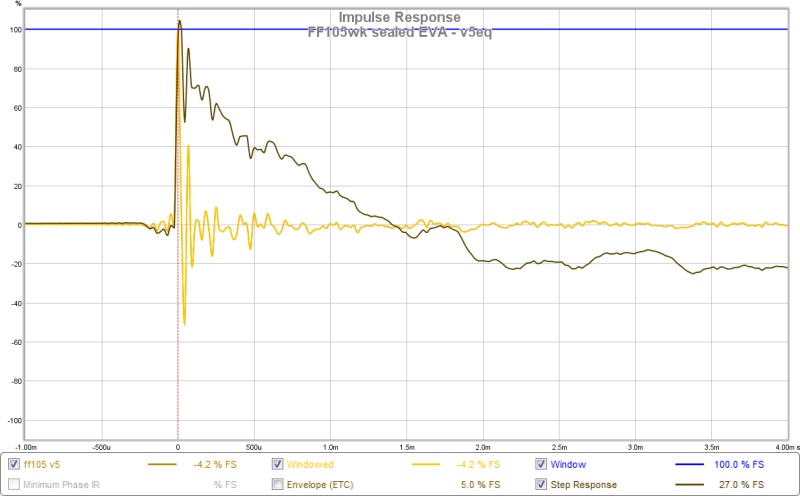
FR and HD after EQ
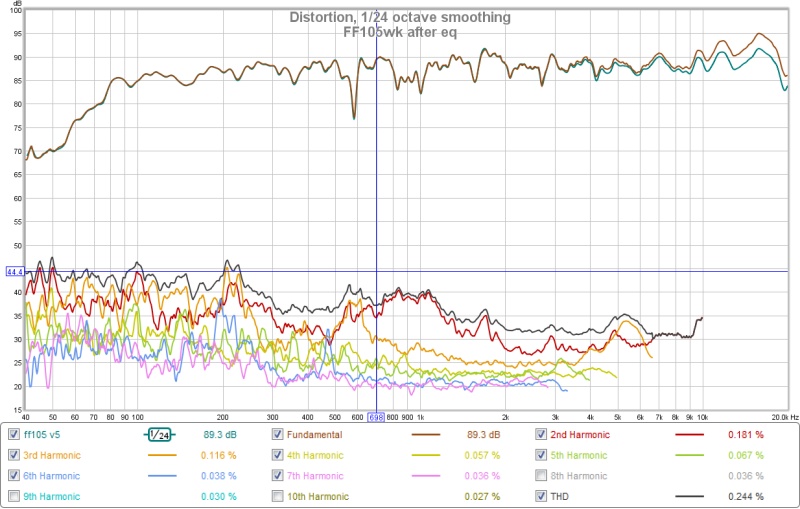
and finally FR and HD before EQ
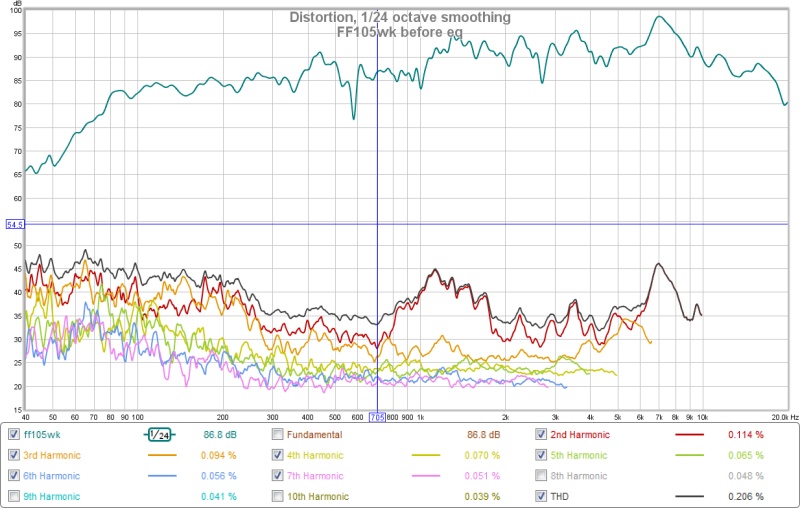
My FF105wk is in a sealed EVA truncated pyramid rhomboid box. I apply 5 notch EQ filters to smooth it out with my miniDSP.
Impulse and step response after EQ (edit: ok maybe this isn't so good)

FR and HD after EQ

and finally FR and HD before EQ

Attachments
Last edited:
Cool. One of my first DIY projects was a reverse taper TL, and I still like them for monitor type speakers. They can sound very realistic with the right drivers.
AFA the 7.5k peak, IMO the best thing is to do a light physical treatment, and EQ the rest digitally. Some might be reticent to tweak a relatively expensive driver, so perhaps a good idea to practice on a cheap paper cone driver first.
A light mist of this should do... Grumbacher Damar Spray Varnish - BLICK art materials
Jeshi: those are really pretty for foam speakers!
AFA the 7.5k peak, IMO the best thing is to do a light physical treatment, and EQ the rest digitally. Some might be reticent to tweak a relatively expensive driver, so perhaps a good idea to practice on a cheap paper cone driver first.
A light mist of this should do... Grumbacher Damar Spray Varnish - BLICK art materials
Jeshi: those are really pretty for foam speakers!
Last edited:
A light mist of this should do... Grumbacher Damar Spray Varnish - BLICK art materials
Can the hand brushed Damar, thinned with turpentine work?
Jeshi,
That Ellamflex is very cool. Troels Graveson says the 15W/8530 is the BEST 5in mid woofer he knows of. $194 gets you entry into the Revelator sliced cone. Specs are indeed impressive.
http://www.troelsgravesen.dk/Ellam-FLEX/15W-8530K00.pdf
I might try designing a TL around this to go with a Revelator D3004 dome tweeter, also $194:
http://www.troelsgravesen.dk/Ellam-FLEX/6600.pdf
That would indeed be a very nice 2 way monitor. Although TG uses a simple ported BR alignement, maybe it would sound better as a TL?
He is using an LR2 XO at 2.1kHz which probably can be turned into a Harsch XO to avoid the negative going leading pulse on the tweeter as he has shown here:
I would have expected a smoother frequency response for such expensive drivers though:
It's interesting that on the Illumina-66 TG uses an asymmetric 2nd and 4th order XO, and except for the slight time alignment offset, it looks almost like a Harsch XO step response:
ScanSpeak says that their 18WU/4741T 7in mid woofer is the BEST money can buy. At $320 ea, I might believe it. Although 5th Element has had some very good luck with the B&W FST, wonder if that is strictly mid only and not mid-bass?
That Ellamflex is very cool. Troels Graveson says the 15W/8530 is the BEST 5in mid woofer he knows of. $194 gets you entry into the Revelator sliced cone. Specs are indeed impressive.
http://www.troelsgravesen.dk/Ellam-FLEX/15W-8530K00.pdf
I might try designing a TL around this to go with a Revelator D3004 dome tweeter, also $194:
http://www.troelsgravesen.dk/Ellam-FLEX/6600.pdf
That would indeed be a very nice 2 way monitor. Although TG uses a simple ported BR alignement, maybe it would sound better as a TL?
He is using an LR2 XO at 2.1kHz which probably can be turned into a Harsch XO to avoid the negative going leading pulse on the tweeter as he has shown here:
An externally hosted image should be here but it was not working when we last tested it.
I would have expected a smoother frequency response for such expensive drivers though:
An externally hosted image should be here but it was not working when we last tested it.
It's interesting that on the Illumina-66 TG uses an asymmetric 2nd and 4th order XO, and except for the slight time alignment offset, it looks almost like a Harsch XO step response:
An externally hosted image should be here but it was not working when we last tested it.
An externally hosted image should be here but it was not working when we last tested it.
ScanSpeak says that their 18WU/4741T 7in mid woofer is the BEST money can buy. At $320 ea, I might believe it. Although 5th Element has had some very good luck with the B&W FST, wonder if that is strictly mid only and not mid-bass?
Last edited:
Yeah, that's normally what I use, and obviously the surrounds won't need to be masked. The turp takes some time to cure though, so it tends to make drivers go dull for a couple weeks until it's fully dried. Paint thinner dries faster. If you buy bottles damar instead of crystals, thin it by half.
The revelators do indeed sound good, though perhaps not the best bang/buck. Qts is a bit low for pure TL, but worth a sim. I'd think an MLTL would work better.
IMO yeah, go for the Harsch. I can always hear the negative leading edge, and so I avoid reverse phase crossovers.
IMO yeah, go for the Harsch. I can always hear the negative leading edge, and so I avoid reverse phase crossovers.
So it is Ok to use mineral spirits as thinner then or can even denatured alcohol be used like in case of dissolving lac bug shells for shellac?
I was very close to building that Ellam Flex as my first speaker to get a high quality monitor. But I started this thread to see if there might be some better driver options.
http://www.diyaudio.com/forums/mult...oice-8945a-8948a-sb15-sb17-satori-ss8530.html
In the end from that discussion and a lot from 5ths advise and some other tests I read, I decided to go for the Satori MW16p-4 rather than the revelator 15W/8530. And when I finally saw one in person I am glad I did. I am sure the revelator is an excellent driver, but the 6.5" satori is also world class.
I think TG's Illumina66 is a slightly older design. Now Troels does everything time aligned and with an LR2 crossover. Actually this new design of his looks really interesting and he almost hints that it is similar to the Ellam Flex (without actuallly saying it). Ellam-Discovery-15 uses the 5" discovery. Overall I like Troels designs a lot and would be tempted to try one if I wanted to do a passive crossover and wood build.
http://www.diyaudio.com/forums/mult...oice-8945a-8948a-sb15-sb17-satori-ss8530.html
In the end from that discussion and a lot from 5ths advise and some other tests I read, I decided to go for the Satori MW16p-4 rather than the revelator 15W/8530. And when I finally saw one in person I am glad I did. I am sure the revelator is an excellent driver, but the 6.5" satori is also world class.
I think TG's Illumina66 is a slightly older design. Now Troels does everything time aligned and with an LR2 crossover. Actually this new design of his looks really interesting and he almost hints that it is similar to the Ellam Flex (without actuallly saying it). Ellam-Discovery-15 uses the 5" discovery. Overall I like Troels designs a lot and would be tempted to try one if I wanted to do a passive crossover and wood build.
Last edited:
Greg B, I know you've mentioned Damar (and sometimes Shellac for dustcaps) many times over the years as your 'secret sauce'.
I tried Damar once, on this recommendation, but that was years ago, before I had a mic & REW. Have you ever taken before and after measurements?
I also have FF105WKs that I'm tempted to tweak.
I tried Damar once, on this recommendation, but that was years ago, before I had a mic & REW. Have you ever taken before and after measurements?
I also have FF105WKs that I'm tempted to tweak.
So it is Ok to use mineral spirits as thinner then or can even denatured alcohol be used like in case of dissolving lac bug shells for shellac?
Mineral spirits is OK for thinner. Probably naphtha would work also. Turp's longer drying time does leave a smoother finish if you are really building it up.
Denatured alcohol won't dissolve damar. Save it for shellac. (real answer slightly more complicated)
I was very close to building that Ellam Flex as my first speaker to get a high quality monitor. But I started this thread to see if there might be some better driver options.
http://www.diyaudio.com/forums/mult...oice-8945a-8948a-sb15-sb17-satori-ss8530.html
In the end from that discussion and a lot from 5ths advise and some other tests I read, I decided to go for the Satori MW16p-4 rather than the revelator 15W/8530. And when I finally saw one in person I am glad I did. I am sure the revelator is an excellent driver, but the 6.5" satori is also world class.
I think TG's Illumina66 is a slightly older design. Now Troels does everything time aligned and with an LR2 crossover. Actually this new design of his looks really interesting and he almost hints that it is similar to the Ellam Flex (without actuallly saying it). Ellam-Discovery-15 uses the 5" discovery. Overall I like Troels designs a lot and would be tempted to try one if I wanted to do a passive crossover and wood build.
I read your thread on how you selected the Satori. Indeed looks like it could be my next mid bass for a ref monitor. Great questions and explanations in there. My current RS225 based monitor is a largish 24liters. I can see why you were trying to keep it at 15liters.
I saw some discussions of miniDSP and transparency vs passive crossovers - what is your impression of the transparency of the base 2x4 miniDSP as far as transparency? I have done the play straight thru test listened and measured and could hear no reduction in sound quality. But then maybe I just don't know what I have not heard. Then saw link to miniDSP 10x10HD review. That unit sounds like it might make a great upgrade for higher quality 4 way system with subs. At $600 doesn't sound so expensive for all that you get including ability to do arbitrary 10x10 crossbar matrix.
Music in the Round #64 Page 2 | Stereophile.com
Last edited:
This same TL, mounted with dual Faital Pro 5FE120's and made 9in wide has an excellent predicted response with flat 89dB sensitivity after baffle step losses. Either cross at 500Hz with a suitable 2in to 3in full range for a FAST TL or with a good dome tweeter higher up at 2kHz for an excellent 2 way monitor. I think the 2 way will be much flatter response than the FF105WK. The sensitivity is excellent with -3dB at 53Hz.
- Status
- Not open for further replies.
- Home
- Loudspeakers
- Full Range
- FF105WK TL for Desktop/Bookshelf
